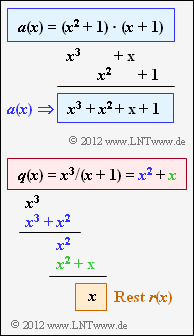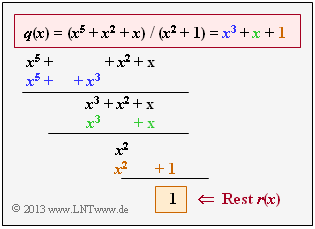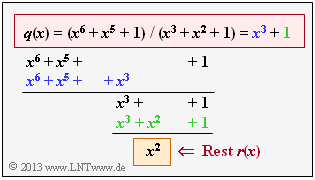Exercise 2.3Z: Polynomial Division
In this exercise we deal with the multiplication and especially the division of polynomials in the Galois field $\rm GF(2)$. In the graph the procedure is indicated by a simple and (hopefully) self-explanatory example:
- Multiplying the two polynomials $x^2 + 1$ and $x +1$ yields the result $a(x) = x^3 + x^2 + x + 1$.
- Dividing the polynomial $b(x) = x^3$ by $p(x) = x + 1$ gives the quotient $q(x) = x^2 + x$ and the remainder $r(x) = x$.
- One can check the latter result as follows:
- $$b(x) \hspace{-0.15cm} \ = \ \hspace{-0.15cm} p(x) \cdot q(x) + r(x)\hspace{0.05cm}= \big[(x+1) \cdot (x^2+x)\big] +x =\big[x^3+ x^2+x^2+ x\big] +x = x^3\hspace{0.05cm}.$$
Hint: This exercise belongs to the chapter "Extension field".
Questions
Solution
- $$a(x) \hspace{-0.15cm} \ = \ \hspace{-0.15cm} (x^3+ x+1) \cdot (x^2+1)= x^5+x^3+ x^2+ x^3+x+1 = x^5+ x^2+x+1\hspace{0.05cm}.$$
- Thus the proposed solution 2 is correct.
- The last solution suggestion cannot simmen already alone, since the degree of the product polynomial would be unequal $5$.
(2) With the abbreviations
- $$a(x) = x^5+ x^2+x+1\hspace{0.05cm},\hspace{0.4cm}p(x) = x^3+ x+1\hspace{0.05cm},\hspace{0.4cm}q(x) = x^2+ 1$$
and the result from subtask (1) we get $a(x) = p(x) \cdot q(x)$.
That is: The divisions $a(x)/p(x)$ and $a(x)/q(x)$ are free of remainders ⇒ Correct are the solutions 1 and 2.
Even without calculation one recognizes that $a(x)/x^2$ must result in a remainder. After calculation it results explicitly:
- $$(x^5 + x^2+x+1)/(x^2) = x^3 + 1 \hspace{0.05cm},\hspace{0.4cm}{\rm Rest}\hspace{0.15cm} r(x) = x+1\hspace{0.05cm}.$$
To the last proposed solution. We use for shortcut $b(x) = x^5 + x^2 + x = a(x) + 1$. This is the given quotient:
- $$b(x)/q(x) = a(x)/q(x) + 1/q(x) \hspace{0.05cm}.$$
- The first quotient $a(x)/q(x)$ gives exactly $p(x)$ without remainder, the second quotient $0$ with remainder $1$.
- Thus the remainder of the quotient $b(x)/q(x)$ is equal to $r(x) = 1$, as the calculation in example 1 shows.
(3) The polynomial division is explained in detail in example 2. Correct is the proposed solution 3.


